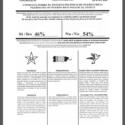Independence is an option for Puerto Rico, but it is not a popular one. In the last vote on status in Puerto Rico, independence got just about 5% of the vote — statehood got 61%.
But there was a third option: becoming an Free Associated State.
Puerto Rico is a territory of the United States now, not a Free Associated State, but there are Free Associated States such as Palau and the Marshall Islands, and this status is a possibility for Puerto Rico under the constitution. A Free Associated State is an independent nation with a treaty that defines its relationship with the United States.
A Free Associated Free State has to negotiate a treaty with the United States. Such a treaty could include some financial or military support from the United States, but the U.S. Congress could end that support at any time. Either side, in fact, can withdraw from the treaty unilaterally — that means that the other side doesn’t have to agree.
If Puerto Rico became a Free Associated State and either side later withdrew, Puerto Rico would be entirely independent — currently an unpopular option.
Citizens of a Free Associated Free State are citizens of their own countries, not of the United States. Now, everyone born in Puerto Rico is a U.S. citizen, but that would not be true if Puerto Rico were a Free Associated State. Travel between a Free Associated State and the U.S. may be easier than travel from an entirely separate independent nation, but citizens of Free Associated States don’t have U.S. passports.
Both Palau and the Marshall Islands use the U.S. dollar as currency, and Puerto Rico probably could continue to do so if it became a Free Associated State. However, all the details of the relationship would have to be negotiated, and neither the United States nor Puerto Rico would be required to continue any particular part of the deal.
As former Governor Rafael Hernández Colón put it, “The sovereign free associated state [ELA Soberano] is the same as independence, except that once independent, Puerto Rico would negotiate the terms of its relationship with the U.S. The fruit of this negotiation would create what would be called the sovereign free associated state. The U.S. doesn’t have to accept this. The U.S. doesn’t have to accept anything. In practical terms, this is like renouncing things we already have, and then asking for them in a future negotiation.”
If Puerto Rico became a Free Associated State, it would not be a State of the United States, and would not have the rights of a State. Where the United States now has some obligation to Puerto Rico because it belongs to the United States, the U.S. would have no obligation to a Free Associated State of Puerto Rico beyond the treaty the U.S. agreed to, and the U.S. (as well as Puerto Rico) could end the treaty at any time.
There is no reason to think that the United States would provide more to Puerto Rico if it were a Free Associated State than it does now. It is more likely that Puerto Rico would be given less in the way of support, and that the support given would (as with the other Free Associated States) become still less as time goes on.
As a Free Associated State, Puerto Rico would be a small Caribbean nation, not a State of the Union. It would not have the benefits of statehood.








2 Responses
[…] DOJ has already said that statehood, independence (with or without a Free Associated State relationship like that of Palau), or continuing as a territory are all the available options. There has been […]
[…] have to accept that people voting for “sovereign free associated state” were actually voting for enhanced commonwealth. “Free associated state” is a […]